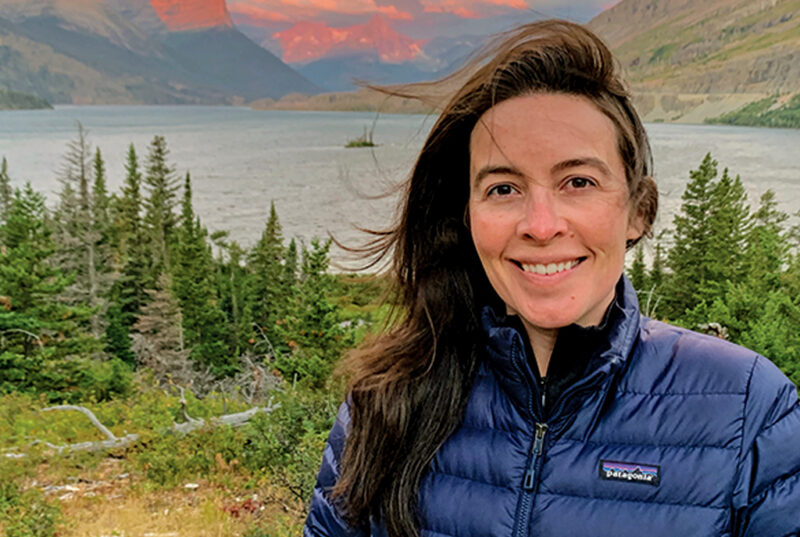Wolves, Deer, and Vehicle Collisions: The Economics of the Natural World

By Annie Roach ’22
Assistant Professor of Economics Jennifer Raynor—whose research focuses on natural resource management, with an emphasis on measuring the unintended consequences of rules and regulations—has dedicated her work to the shared space between ecology and economics. Her recent paper titled “Wolves Make Roadways Safer, Generating Large Economic Returns to Predator Conservation” provided a concrete and quantifiable estimate of the benefits of wolves to local communities in Wisconsin and garnered national attention, both from the world of academia and the popular press. In this Q&A, Raynor, who came to Wesleyan in 2019 and is a 2021-22 College of the Environment Think Tank fellow, shares more about her research, love of teaching, and passion for interdisciplinary study.
How did you first get into the field of economics and what about it initially interested you? How did that lead you to the interdisciplinary work that you do?
I started in undergrad as an econ major, focused on poverty and inequality in education policies. I’ve always been really interested in the environment and the outdoors and animals, and I read this paper by the World Wildlife Fund about how bluefin tuna were being depleted. They used to be one of the biggest mass migrations of animals on the planet, and we have significantly reduced their populations through over-fishing. It is upsetting that we make this same mistake over and over, depleting these natural resources. It struck me that that was an economics question. I didn’t see the link between economics and ecosystems clearly until that point. It was the first time that I linked that sustainability problems are both caused by economics and also can be solved by economics. I got really excited about moving into this environmental focus with my degree and focusing on those linkages between the economy and ecosystems.
Your bio says that your work “combines theoretical models from economics and ecology with empirical techniques from econometrics and machine learning to measure the economic effects of management actions and inform decision-making.” Can you explain a little bit what that means?
I’m an interdisciplinary researcher. I take theoretical understanding of how the world works from different disciplines, like economics and ecology, and estimate these different relationships using different types of tools. For example, in my wolf paper I try to see what happens to vehicle collisions with deer when wolves move into a county. I bring together ideas from ecology—how wolves coming into an ecosystem affect deer populations and deer behavior—and then use tools from my main discipline, economics, to measure those things in a really precise way and quantify how big the economic effect of those changes is. I’m bringing together ideas from ecology with cutting-edge, modern statistical techniques.
That research on vehicle collisions caused by deer got a lot of press attention (The Atlantic, The Associated Press, The Washington Post, The Economist, Scientific American, to name a few). What do you think made this research so compelling to the wider public?
I’m thrilled with how much interest this paper has gotten across a wide range of groups, be that popular press or academics in different disciplines. I think one reason is that wolves have a really special place in the culture; they’re very charismatic and also very polarizing. Second, we’re also speaking to an effect that is familiar to everybody. In many places, deer are overpopulated. It’s a scenario that people can relate to. Third, it’s both intuitive and surprising. It’s something that people maybe didn’t think about, but once you hear it, it makes sense.
The timing was also fortuitous in that many states right now are proposing big policies and programs to manage their wolf populations. The federal government has recently removed wolves from its endangered species list. I think wolves are very policy-relevant at the moment. These effects could really matter for how states are thinking about managing their wolves.
What drew you to Wesleyan?
I went to a liberal arts college for my undergrad, I’m a big believer in liberal arts education, and I think it’s a great way to help people build skills they need to be civic-minded and engaged in policies. I really like teaching and having opportunities to interact with amazing students. I’m passionate about helping people see that economics isn’t just the problem, it also can be the solution. I enjoy teaching these kinds of ideas in my classes to help people see economics through a broader view of what we can do in this field.
For me, interdisciplinary methods, collaborators, and ideas have made my research so much better and more interesting than if it was purely economics. Wesleyan has a lot of people who are interested in this interdisciplinary work, something that’s surprisingly not always encouraged at universities. And the College of the Environment and Environmental Studies program are really unique because they give people the opportunity to bring together these different disciplines in a more comprehensive way than you might get from just one field. I appreciate that this is something that is really valued at Wesleyan.
What is your favorite part about working with Wesleyan students?
Our students really understand the magnitude of [environmental] problems and care about fixing them. I also love that people are open-minded. A lot of people come in thinking economics is the problem without seeing the extra part, which is that there are solutions too. People seem very willing to change their minds as the course of the semester goes on, which is exciting.
You started here in 2019, right before the pandemic. How has the pandemic impacted your teaching?
I think the pandemic has completely disrupted everything we do. It impacted my research, it impacted my broader service, it affected my teaching—it was incredibly disruptive on pretty much every level. But I also think there’s been a real silver lining, and I think the silver lining is that we as a profession—teachers, educators—are now better at being accommodating and flexible when people need it. I’ve seen in the profession a broad movement towards being more flexible. I think this really helps with diversity. Certain types of students can meet every deadline thrown at them and do everything we ask them to do, but other people can’t for reasons that are totally reasonable. We’re now better at being more inclusive to more types of historically underrepresented students.
What is next for you?
We’re expanding the wolf paper research to all states that have wolves and to other things that wolves might affect, like kills of livestock or other outcomes. I’m super excited to see what that looks like. It will give us an idea of whether Wisconsin is unique, or whether it’s similar in other states that have very different economic sectors and different ecology or landscapes. It’ll be really cool to see how these things trade off when we’re moving to a different region.



